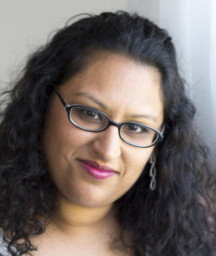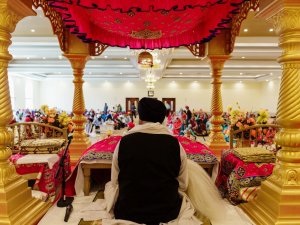“You’ve never cut your hair? Not even a trim? No way…it’s so short!” A phrase I heard my whole life. By some genetic quirk, I was born with thick ringlets that barely reach my shoulder blades. It was hard for others to believe that I had abided by the Sikh rule of keeping kesh and staying true to the form Waheguru intended for me. It was easier for them to believe that I was just another Sikh girl who came from a “Gursikh family” that secretly (or not so secretly) cut my hair.
But, I didn’t. I can honestly say I have never even been tempted to cut, trim, or even burn off the ends with a curling iron (as I heard other girls doing as a way of “getting around” the rule). And yet, I allowed this idea of the “Sardarni Image” to make me feel like less of a “Kaur”. I’m sorry to say that as I compared myself to the girls around me, with hair flowing past their waists, I found myself coming up (forgive the pun) … short.
It’s a complicated paradigm – we are supposed to be comfortable and rejoice in the form that Waheguru gave us…and yet, the form I was given never felt worthy. I felt this especially when I compared myself to patka-wearing boys. They always had it harder, standing out with their patkas, facing ever-increasing negativity… and so – was it wrong that I had it easier than them?
Shouldn’t I look more different? Stand out more? In order to be a TRUE Kaur, shouldn’t it be harder?
I’ve been asked if I’m Hispanic, West Indian, Thai, Filipino, and just about every mix of ethnicity you can imagine. In looking like I belong to so many groups, I felt that I didn’t properly embodied the one group I was so proud to be a part of.
I worried over this. I tried to find ways to wear my Sikhi outside, to make my physical embody what I believed I had on the inside. The truth is that none of it ever reconciled my conflict.
And then, all of a sudden, I became a “grown up”. I moved to another country to start a new life with a new husband – no family, no friends, no job. Completely starting over at 26, I changed careers, I became a tough New Yorker (for a born and raised Canadian girl – not a small feat!), I had a child, weathered all kinds of crises, and through it all….I had my KAUR to keep me strong.
And it hit me. My Kaur-ness wasn’t something I wore on the outside. It wasn’t visible to the naked eye. My Kaur was the Core of me.
I realized that soon as I started thinking, “I’m a bad Sikh because I look like X,” and “She’s a good Sikh because she looks like Y” – I was on the wrong path.
Sikhi has a physical identity, we cannot deny that. “Khalsa mero roop hai kaas,” (The Khalsa is my true form) – a statement attributed to Guru Gobind Singh Ji, gives us strength when it’s hard to stand out. The mistake I made was assuming that it’s the image others see that determines our inner identity. I’ve come to see that it is each individual’s responsibility to mirror their core to their outward appearance. It is not my job to determine if another individual is doing it right… and perhaps more importantly, it’s not my job to convince anyone else that I am doing it right either.
Main Photo by William Stitt
 Tajinder Kalia is the owner of Sateela Tree, creating art, accessories and apparel for the modern Sikh, including the slogan “Kaur to my Core .” Tajinder lives in NYC with her husband and 4-year-old son, and can be regularly found trying to solve all of life’s problems on spreadsheets. You can contact her at sateelatree(at)gmail.com, or etsy.com/shop/sateelatree.
Tajinder Kalia is the owner of Sateela Tree, creating art, accessories and apparel for the modern Sikh, including the slogan “Kaur to my Core .” Tajinder lives in NYC with her husband and 4-year-old son, and can be regularly found trying to solve all of life’s problems on spreadsheets. You can contact her at sateelatree(at)gmail.com, or etsy.com/shop/sateelatree.





